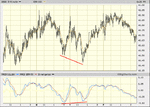StockTiger
Junior member
- Messages
- 33
- Likes
- 5
The QLD
Actually I use Slow Stochastics but it is only a personal preference.
Just to point out that while the QQQQ has more liquidity at ave volume of 112 million the pretty new ETF - QLD with 281k is enough for traders. This ETF gives twice the performance of the QQQQ.
Obviously the better leveraged trade is using futures but for those who cannot they can use the QLD.
Yesterday the QQQ gave a minor gain of 1.76% and (ran back to resistance)

The QLD does not yet have much history but notice the percentage gain at 3.69% - more then twice that of the QQQQ. So if one uses the Qs now as a hedge or a trade consider the advantage to the QLD if you wish more leverage.

Actually I use Slow Stochastics but it is only a personal preference.
Just to point out that while the QQQQ has more liquidity at ave volume of 112 million the pretty new ETF - QLD with 281k is enough for traders. This ETF gives twice the performance of the QQQQ.
Obviously the better leveraged trade is using futures but for those who cannot they can use the QLD.
Yesterday the QQQ gave a minor gain of 1.76% and (ran back to resistance)

The QLD does not yet have much history but notice the percentage gain at 3.69% - more then twice that of the QQQQ. So if one uses the Qs now as a hedge or a trade consider the advantage to the QLD if you wish more leverage.




